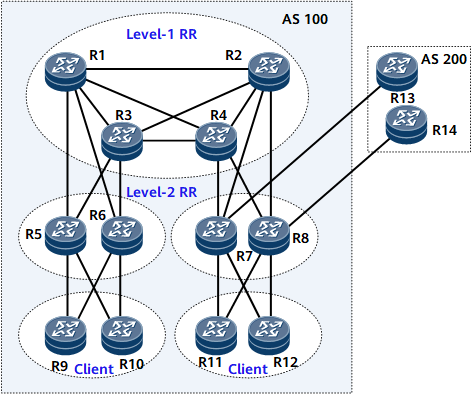Configuring a BGP Route Reflector
By configuring a BGP route reflector (RR), you can avoid fully meshed connections between multiple IBGP peers.
Usage Scenario
Fully meshed connections need to be established between IBGP peers to ensure the connectivity between IBGP peers. If there are n routers in an AS, n x (n–1)/2 IBGP connections need to be established. When there are a lot of IBGP peers, network resources and CPU resources are greatly consumed. Route reflection can solve the problem.
RRs can reduce the total number of IBGP connections. On a large network, to reduce the number of clients of each route reflector, you need to configure multiple RRs. Because fully meshed connections need to be established between RRs, there are still a large number of IBGP connections on the network. In this situation, configure hierarchical RRs to further reduce the number of IBGP connections.
Figure 1 shows typical networking with hierarchical RRs. In this networking, R1, R2, R3, and R4 function as Level-1 RRs; R5, R6, R7, and R8 function as level-2 RRs and the clients of level-1 RRs. Level-1 RRs are not the clients of any RR and must be fully meshed. Level-2 RRs function as the clients of Level-1 RRs and do not need to be fully meshed.
- Configuring a Route Reflector and Specifying Clients
- RRs can reflect routes between clients, and clients do not need to establish IBGP connections.
- (Optional) Disabling Route Reflection Between Clients Through the RR
- If the clients of a route reflector are fully connected, you need to disable route reflection among them through the RR to reduce bandwidth consumption.
- (Optional) Setting the Cluster ID of a Route Reflector
- When there are multiple route reflectors in a cluster, you need to configure the same cluster ID for all the route reflectors in this cluster to avoid routing loops.
- (Optional) Preventing a Device from Adding BGP Routes to the IP Routing Table
- After you prevent an RR from adding BGP routes to the IP routing table, the RR no longer forwards traffic, which improves route advertisement efficiency.
- (Optional) Enabling an RR to Modify Route Attributes Using an Export Policy
- You can enable an RR to modify route attributes using an export policy to control BGP route selection.
- Verifying the BGP Route Reflector Configuration
- After configuring a BGP route reflector, verify information about BGP routes and BGP peer groups.
